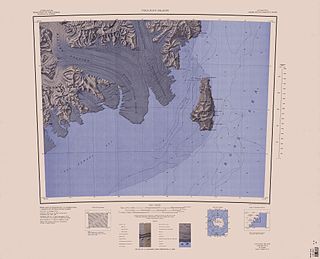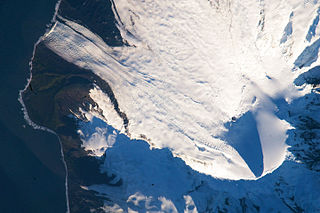
The Arctic Archipelago, also known as the Canadian Arctic Archipelago, is a group of islands north of the Canadian mainland.

The Flores Sea covers 240,000 square kilometres (93,000 sq mi) of water in Indonesia. The sea is bounded on the north by the island of Celebes and on the south by Sunda Islands of Flores and Sumbawa.

Borchgrevink Glacier is a large glacier in the Victory Mountains, Victoria Land, draining south between Malta Plateau and Daniell Peninsula, and thence projecting into Glacier Strait, Ross Sea, as a floating glacier tongue, the Borchgrevink Glacier Tongue, just south of Cape Jones. It was named by the New Zealand Geological Survey Antarctic Expedition, 1957–58, for Carsten Borchgrevink, leader of the British Antarctic Expedition, 1898–1900. Borchgrevink visited the area in February 1900 and first observed the seaward portion of the glacier.

Abbotsmith Glacier is a well-defined glacier, 3 miles (5 km) long, descending from the ice-covered west slopes of Big Ben to the west side of Heard Island in the southern Indian Ocean. The glacier lies between Walsh and Henderson Bluffs. Surveyed in 1948 by the ANARE who named it for John Abbotsmith, engineer with the party.

Baudissin Glacier is a tidewater glacier on the north side of Heard Island. in the southern Indian Ocean. Located 1 nautical mile (1.9 km) west of Challenger Glacier, Baudissin Glacier is 1.5 nautical miles (2.8 km) wide and flows into the western part of Corinthian Bay. The terminus of Baudissin Glacier is located at the western side of Corinthian Bay, at Sealers Cove. To the east of Baudissin Glacier is Challenger Glacier, whose terminus is located at the eastern side of Corinthian Bay, close west to Saddle Point. To the south of Baudissin Glacier is Schmidt Glacier, and to the northwest is Atlas Cove. Kildalkey Head is west of Schmidt Glacier. To the south of Schmidt Glacier is Vahsel Glacier, whose terminus is at South West Bay, between Erratic Point and Cape Gazert. Immediately south of Vahsel Glacier is Allison Glacier. Click here to see a map of Baudissin Glacier and the northwestern coast of Heard Island.

Brown Glacier is a glacier just south of Round Hill on the east side of Heard Island in the southern Indian Ocean. Its terminus is at Brown Lagoon. To the northwest of Brown Glacier is Compton Glacier, whose terminus is located at Compton Lagoon, between Gilchrist Beach and Fairchild Beach. To the southeast of Brown Glacier is Stephenson Glacier, whose terminus is located between Dovers Moraine and Stephenson Lagoon.

Cape Arkona is a rocky headland between the mouths of Lied Glacier and Gotley Glacier on the southwest side of Heard Island in the southern Indian Ocean. The feature appears to be roughly charted on an 1860 sketch map prepared by Captain H.C. Chester, an American sealer operating in the area during this period. The German frigate Arkona examined the south coast of the island in February 1874 and, in Melbourne, provided the officers of HMS Challenger with a position for the cape which was used in preparation of the Admiralty chart. In so doing, however, the misspelling "Cape Arcona" was used on the British chart.

Vahsel Glacier is a glacier on the northwestern side of Heard Island in the southern Indian Ocean. It flows west into South West Bay, between Erratic Point and Cape Gazert. Immediately to the north of Vahsel Glacier is Schmidt Glacier, whose terminus is located between Mount Drygalski and North West Cornice. To the south of Vahsel Glacier is Allison Glacier, whose terminus is located south of Cape Gazert, which separates Allison Glacier from Vahsel Glacier. Click here to see a map of Vahsel Glacier and the northwestern coast of Heard Island.
Fairchild Beach is a sandy beach, 0.3 nautical miles (0.6 km) wide and 1 nautical mile (2 km) long, which extends north from the base of Round Hill to the south side of the terminus of Compton Glacier, on the east side of Heard Island in the southern Indian Ocean. The beach faces Compton Lagoon, and at its western edge communicates with the rocky Gilchrist Beach. To the south of Fairchild Beach is Brown Glacier, whose terminus is located at Brown Lagoon.
Round Hill is an ice-free, rounded hill rising southward of Fairchild Beach and between Compton Glacier and Brown Glacier, on the northeast side of Heard Island. Travelling westwards from the sandy Fairchild Beach at the base of Round Hill, one arrives at the rocky Gilchrist Beach.

Allison Glacier is an ice stream on the west side of Heard Island in the southern Indian Ocean. Allison Glacier flows from Big Ben massif down to the sea to the south of Cape Gazert.
To the north of Allison Glacier is Vahsel Glacier, whose terminus is at South West Bay, between Erratic Point and Cape Gazert. Immediately to the north of Vahsel Glacier is Schmidt Glacier, whose terminus is located between Mount Drygalski and North West Cornice. To the south of Allison Glacier is Abbotsmith Glacier, while Cape Gazert is immediately west.
South West Bay is an open bay indenting the west side of Heard Island immediately north of Cape Gazert in the southern Indian Ocean. The bay was roughly charted on an 1860 sketch map compiled by Captain H.C. Chester, an American sealer. The name "S.W. Bay" appears on an 1882 chart compiled by Ens. Washington Irving Chambers aboard the USS Marion at Heard Island in January 1882. The bay name appears to have developed from an American sealer name, "Southwest Beach," in use about 1860 for the pebble beach at the north end of this bay.
Erratic Point is a small, moss-covered point at the head of South West Bay, 1.3 nautical miles (2.4 km) northeast of Cape Gazert, on the west side of Heard Island in the southern Indian Ocean. The First German Antarctica Expedition in 1902 charted a cape in this vicinity, from the summit of Mount Drygalski, and applied the name "Kap Lerche." In November 1929 the British Australian and New Zealand Antarctic Research Expedition under Douglas Mawson charted a small point in this position and applied the name "Erratic Point" because of the large number of massive erratic boulders encountered there. The Australian National Antarctic Research Expedition was unable to find any significant feature in this immediate area during their 1948 survey of the island, hence the name Erratic Point was retained by them for this small point.
Cave Bay is a cove, 0.3 nautical miles (0.6 km) wide, which has been formed by the erosion of an extinct volcanic crater of which Mount Andree forms the north side, indenting the west side of Heard Island between West Bay and South West Bay. The cove is roughly charted on an American sealer's sketch map prepared during the 1860–70 period. It was more accurately charted and first named on a geological sketch map illustrating the 1929 work of the British Australian New Zealand Antarctic Research Expedition under Douglas Mawson.

Noble Glacier is a small glacier lying just north of Flagstaff Glacier on the east side of Keller Peninsula, King George Island, in the South Shetland Islands. Named by the United Kingdom Antarctic Place-Names Committee (UK-APC) in 1960 for Hugh M. Noble of Falkland Islands Dependencies Survey (FIDS), glaciologist at Admiralty Bay in 1957, who made detailed studies of the regime of Flagstaff and Stenhouse Glaciers.
North Barrier is a narrow rock ridge which descends northward from Campbell Peak to Mount Separation, and then along the northwest flank of Compton Glacier in northern Heard Island. The descriptive name was applied by ANARE in 1948.
Little Matterhorn is a rocky peak, 1,480 metres (4,860 ft) high, formed by a small volcanic cone 1.1 nautical miles (2 km) north-northwest of Fremantle Peak, on the north flank of Big Ben, the dominating mountain on Heard Island. It was surveyed and named in 1948 by the Australian National Antarctic Research Expedition.
Tighe Rock is a rock outcropping along the coastal slope at the west margin of the Hudson Mountains, located 15 nautical miles (28 km) northwest of Mount Moses. Mapped by United States Geological Survey (USGS) from surveys and U.S. Navy air photos, 1960-66. Named by Advisory Committee on Antarctic Names (US-ACAN) for Robert F. Tighe, electrical engineer at Byrd Station, 1964-65.
Church Rock is a dark, steeple-like rock, 16 m high, lying at the head of Corinthian Bay opposite the terminus of Baudissin Glacier, off the north side of Heard Island.



![]()






